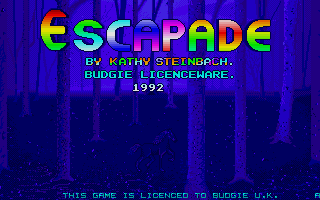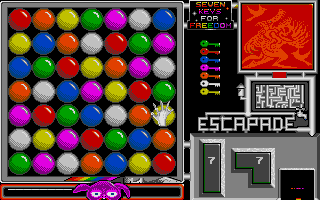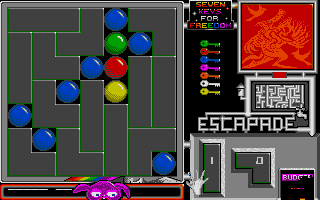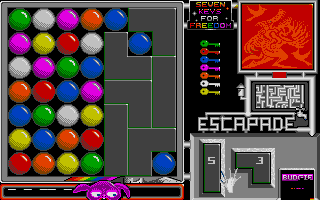Retro Replay Review
Gameplay
Escapade centers around a clever tile-covering puzzle that gradually unfolds as you attempt to earn seven colored keys to secure your freedom. At its core, you’ll use a simple drag-and-drop interface to place fourteen covering tiles—seven straight and seven bent—onto a grid filled with multicolored fields. By rotating pieces with the right mouse button and positioning them precisely with the left, you seek to cover every color except the one you wish to collect. This elegant mechanic rewards careful planning and spatial reasoning, striking a satisfying balance between challenge and accessibility.
The puzzles start off straightforward, with small grids and obvious placements, but quickly evolve into fiendish brain-teasers. Later levels introduce larger playfields and tighter constraints on tile placement, forcing you to think several moves ahead. While there’s no in-game hint system, each puzzle feels fair: mistakes are visible immediately, and you can easily undo moves or reset the board to start fresh. For players who relish trial and error, this feedback loop keeps frustration at bay and encourages experimentation.
Controls are intuitive. Moving and rotating tiles feels natural, and the responsive interface ensures placements snap into position cleanly without irritating misfires. Even on modest hardware, the game tracks your cursor smoothly, which is crucial when you’re hunting for that one perfect angle to clear a field. Overall, Escapade’s gameplay loop of selecting, rotating, and dropping pieces is both addictive and accessible to puzzle veterans and newcomers alike.
Graphics
Escapade opts for a clean, minimalist aesthetic that complements its cerebral gameplay. The game’s cell atop the sentinel tower is rendered in moody tones of gray and cold stone, evoking a sense of isolation. Against this backdrop, the vibrant tiles—each color representing a different key—pop with clarity, making it easy to track which fields remain uncovered. Simple animations, such as the tile snapping into place or the cell’s torch flickering, add a touch of atmosphere without distracting from the puzzles.
While not a showcase of cutting-edge visuals, the art direction works in service of the experience. Every screen feels deliberate: the interface elements are neatly arranged along the edges of the playfield, and the mouse cursor highlights interactable pieces in a gentle glow. Subtle particle effects play when you complete a color field, underscoring each victory without overdoing it. Whether you’re playing on a desktop or a lower-spec laptop, the game maintains a consistent frame rate and crisp graphics.
Transitions between levels are smooth, with brief cutscenes showing the rise and fall of torches in the stone walls. Although the setting is largely static, these small details reinforce the medieval dungeon ambiance. Colorblind options are available, substituting patterned overlays for hues, which is a welcome inclusion that broadens accessibility without compromising art style.
Story
Set during the reign of King Louis VI in a reimagined second medieval age, Escapade weaves a succinct yet compelling narrative. You awaken in a lonely cell perched atop a sentinel tower, condemned by royal decree. Two exits lie before you: one leads to the seven gates of hell, the other to uncertain freedom—locked behind a mysterious puzzle device. From the outset, the game’s lore delivers clear stakes: succeed and live, fail and face eternal damnation.
Most storytelling occurs through environmental details and brief text interludes between puzzles. Cracked walls, rusted chains, and the distant echo of clanking armor lend the world texture, while occasional journal entries reveal snippets of the king’s cruel justice and your determination to escape. Though sparse, these narrative touches heighten tension, making each puzzle feel like a meaningful step toward salvation—or damnation if you stray from the path.
The overarching arc—the quest to collect seven colored keys—provides a satisfying sense of progression. Each completed puzzle unlocks a small piece of the story, culminating in a dramatic final sequence when the last key slots into place. While players seeking an elaborately written saga might find the plot minimal, Escapade’s tight focus on escape and survival more than compensates with palpable urgency and medieval flavor.
Overall Experience
Escapade offers a distilled puzzle experience wrapped in a moody medieval setting that will appeal to fans of spatial logic games. The progression from simple grids to devilishly complex layouts feels natural, and the absence of superfluous mechanics keeps the focus squarely on thoughtful placement and strategy. Whether you tackle the puzzles at a casual pace or race against the clock, the core gameplay loop remains engaging from start to finish.
With its clean graphics, responsive controls, and well-paced difficulty curve, the game delivers a polished package that belies its modest production scale. The narrative—while brief—provides enough context to motivate your efforts, and the audio design (ambient drips, distant torches) deepens immersion without overwhelming. Replay value stems largely from mastering particularly tough boards or racing to beat previous completion times.
In sum, Escapade is a compelling little gem for puzzle aficionados and medieval enthusiasts alike. It may not boast sprawling worlds or action-packed thrills, but its intelligent design and atmospheric presentation ensure a rewarding journey up the sentinel tower. If you enjoy methodical, brain-teasing challenges wrapped in a dark, story-driven shell, Escapade is well worth your time—and a strategic addition to any puzzle game collection.
 Retro Replay Retro Replay gaming reviews, news, emulation, geek stuff and more!
Retro Replay Retro Replay gaming reviews, news, emulation, geek stuff and more!







Reviews
There are no reviews yet.